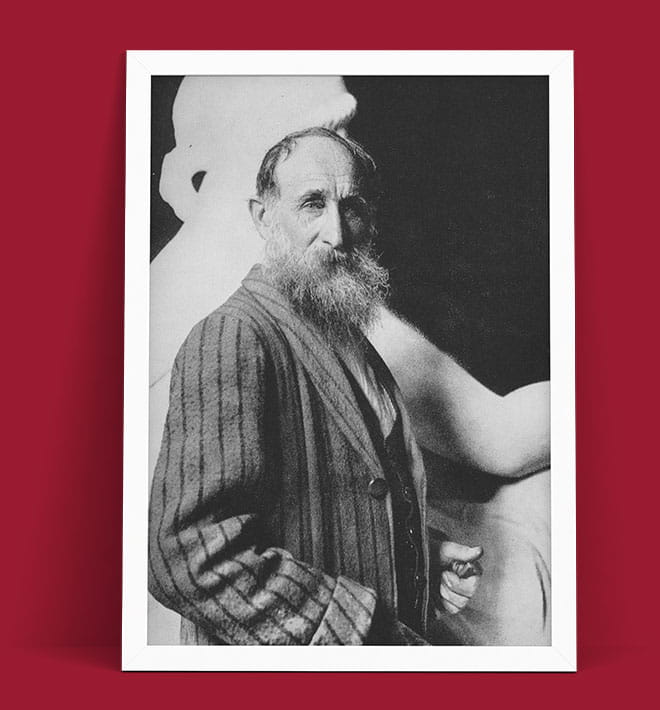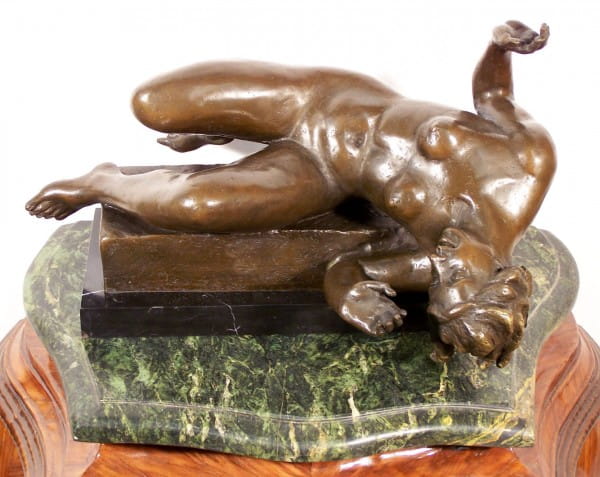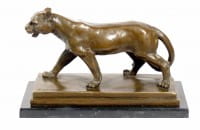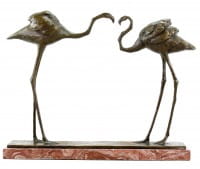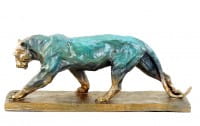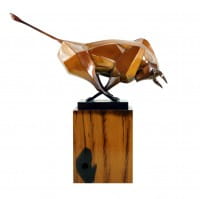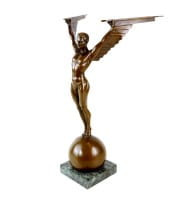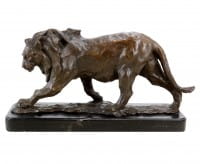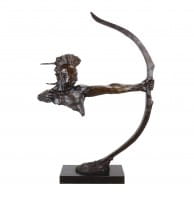Prices incl. VAT, free shipping worldwide
Ready to ship today,
Delivery time appr. 3-6 workdays










Product description
"Bronze Sculpture - La Riviere - by Aristide Maillol"
| Weight | 13 kg |
Modern Movement in Bronze – La Rivière – Signed Aristide Maillol
The bronze figure La Rivière (The River) depicts a woman not at rest, but in dynamic collapse, as if carried by an invisible current. Her body twists diagonally, one leg bent, the other extended, her left arm thrown over her head, the right curved protectively inward. Her head is turned, her expression serene, yet her pose expresses movement, imbalance, and surrender. This is not a typical reclining nude. It is one of Aristide Maillol's most striking sculptures, embodying strength through vulnerability and form through movement.
A Sculptor Rooted in the Classical World
Aristide Maillol, born on December 8, 1861, in Banyuls-sur-Mer, was a French sculptor who translated classical ideals into modern form. Originally trained as a painter and tapestry artist, he turned to sculpture in his thirties and soon became known for his serene, full-bodied female figures, which reflected the timeless tranquility of Greek statues. Yet Aristide Maillol was no mere imitator of antiquity. He redefined the sculptural act by emphasizing volume, presence, and the architectural weight of the human form. His work was not theatrical—it was monumental in its stillness.
The Concept of La Rivière
The idea for La Rivière first emerged in 1938/39, when Maillol began exploring the concept of a figure in motion rather than stillness. It marked a radical departure from his earlier compositions, which emphasized stability and symmetry. The sculptor worked on the scaled plaster model for several years and completed it in 1943 in his studio in Marly-le-Roi. The figure of La Rivière neither stands nor sits—it falls, laid diagonally across a wedge-shaped support that reflects the force of a torrent. Among Aristide Maillol's sculptures, this work is unique in its expression of instability as beauty.
Casting a Legacy in Bronze
Between 1938 and 1943, the model of La Rivière was developed and refined, but was not cast in bronze until after Maillol's death in 1948. The casting was carried out under the supervision of authorized foundries to precisely preserve the integrity of the original plaster. The figure's flowing limbs and curved torso were rendered in bronze with such precision that each gesture preserves the softness of the clay and the urgency of its conception.
Volume in Motion – The Contradiction Made Visible
Although La Rivière is made of solid bronze, she appears to be moving. The sculpted female body has weight, but this weight is thrown off balance in mid-movement—on the verge of collapse. The mass of the figure flows like a liquid. This paradox between material and movement defines Aristide Maillol's genius. The woman's nakedness is not eroticized, but elemental. Her vulnerability becomes strength. Her fall is not a defeat, but a transformation. In contrast to the harmonious stillness of Aristide Maillol's earlier sculptures, La Rivière evokes the relentless, unpredictable beauty of nature.
Timeless Presence in Prestigious Collections
Today, La Rivière is housed in some of the world's most prestigious collections. A monumental version is on display in the gardens of the Musée d'Orsay in Paris, while other casts can be seen at the Museum of Modern Art in New York, the Kunsthaus Zürich, and the Musée Maillol, which is dedicated to the sculptor's legacy. These institutions have recognized "La Rivière" not only as one of Aristide Maillol's most powerful sculptures, but also as a milestone in modern sculpture—where mass yields to movement and form becomes emotion.
A Modern Icon of Sculptural Expression
With "La Rivière," Aristide Maillol conveyed his final artistic message: the human figure can express both permanence and change. The bronze edition of this sculpture offers collectors and curators a rare opportunity to own one of the few posthumous works that fully embodies Maillol's mature style. It bridges his classical past and a modern future, inviting the viewer not to admire from afar but to feel the pull of the river within their bodies. It is a work that moves—visually, emotionally, and forever.
Width: 37,5 cm
Height: 24 cm
Depth: 30 cm
Weight: 13 kg
100% Bronze
Our advantages
free shipping
Worldwide free shipping
14 days money back
You can cancel your order
within 14 days
secure payment services
Paypal, Master Card, Visa, American Express and more

